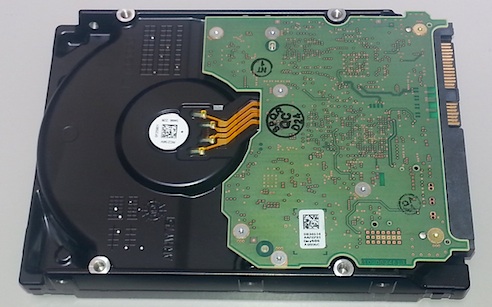München, Starnberg, 28. April 2016 - Meldung von Red Hat im Auftrag der Ceph Community; Betriebssystem und Anwendung direkt auf dem (WD-)Drive ausführen…
Zum Hintergrund: Server goes Storage... Ceph ist die verbreitetste Storage-Option für OpenStack (eingesetzt von 57 Prozent der Befragten der aktuellsten OpenStack User Survey). Als Open-Source- und Software Defined Storage-Lösung steht Ceph für robusten Betrieb, Performance und Skalierbarkeit von Terabytes bis hin zu Exabytes und ist damit für Cloud-Deployments prädestiniert. In dieser Mitteilung von Red Hat im Auftrag der Ceph Community wurde die Implementierung einer neuen Large-Scale Ceph-Storage-Cluster-Umgebung bekanntgegeben. Der preiswerte, energieeffiziente Vier-Watt-Microserver, entwickelt von den WDLabs (Business-Inkubator von Western Digital Corporation), stellt danach die erste Lösung dar, um umfangreiche Ausführungen von Anwendungen auf einem Microserver zu unterstützen.
Ceph Storage wird in diesem Beispiel dazu direkt auf dem Laufwerk ausgeführt. Das Ethernet-attached WD-Ultrastar-Drive (Abb. 1 unten) beinhaltet eine (Micro-)Serverplatine, um im Prinzip jedes Betriebssystem und Software direkt auf dem Laufwerk zu betreiben – wie hier z.B. den Ceph object storage daemon (OSD) in Verbindung mit Red Hat Application Clusters. Durch die Parallelität der Architektur werden sowohl Performance- also auch Verfügbarkeitsaspekte adressiert (n-JBOD-drives / siehe auch Abbildung unten).
Erstes Fazit: Storage goes Server oder Server goes Storage?! Ein neuer Ansatz, der gerade für hochskalierbare Umgebungen wie OpenStack bisherige Konnektivitäts-Problematiken adressiert und die parallele Ausführung von Storage Management Tasks mit geringen Latenzen ermöglichen kann.
Nachfolgend finden Sie weitere Informationen als Auszüge aus der (Red Hat) Originalmeldung bzw. Ceph Community Blog:
"As the enterprise expands into cloud architecture and scale-out systems, it is becoming increasingly important to have hardware profiles that match specific needs and designs. The large scale Ceph storage cluster demonstration using 504 WDLabs converged microservers allows users to load any operating system and software on the device, enabling Ceph storage to run directly on the drive. Testing conducted by WDLabs showed that implementation of the server can also reduce costs when building out future Ceph storage and Red Hat application clusters. This self-contained design is an ideal match for Ceph’s scale-out architecture. The Ceph object storage daemon (OSD) fits on each microserver, creating a flat parallel space. The microserver architecture is designed to localize the problem if a server is ever lost without impacting the entire rack of JBOD drives.
504 OSD Ceph cluster on converged microserver ethernet drives – posted on April 26th, 2016: When Ceph was originally designed a decade ago, the concept was that “intelligent” disk drives with some modest processing capability could store objects instead of blocks and take an active role in replicating, migrating, or repairing data within the system. In contrast to conventional disk drives, a smart object-based drive could coordinate with other drives in the system in a peer-to-peer fashion to build a more scalable storage system. Today an ethernet-attached hard disk drive from WDLabs is making this architecture a reality. WDLabs has assembled over 500 drives from the early production line and assembled them into a 4 PB (3.6 PiB) Ceph cluster running Jewel and the prototype BlueStore storage backend. WDLabs has been working on validating the need to apply an open source compute environment within the storage device and is now beginning to understand the use cases as thought leaders such as Red Hat work with the early units. This test seeks to demonstrate that the second generation converged microserver has become a viable solution for distributed storage use cases like Ceph. Building an open platform that can run open source software is a key underpinning of the concept.
- The WDLabs Converged Microserver He8: The Converged Microserver He8 is a microcomputer built on the existing production Ultrastar® He8 platform. The host used in the Cephcluster is a Dual-Core Cortex-A9 ARM Processor running at 1.3 GHz with 1 GB of Memory, soldered directly onto the drive’s PCB (pictured). Options include 2 GB of memory and ECC protection. It contains the ARM NEON coprocessor to help with erasure code computations and XOR and crypto engines."
Abb. 1: Bildquelle Ceph Community, WDLabs Drive
+++ Hinweis: Detaillierte Informationen zu den Themen OpenStack Cloud, Red Hat Software Defined Storage und Ceph erhalten Sie in Rahmen unserer kommenden Anwendertagung am 16. Juni in Frankfurt a.M. +++ Sie erhalten dort hochwertige und praxisnahe Informationen aus 1. Hand und treffen erfahrende Kollegen-innen zum fachlichen Austausch.
> Agenda & Registrierung: 17. Anwendertagung des Storage Consortium

